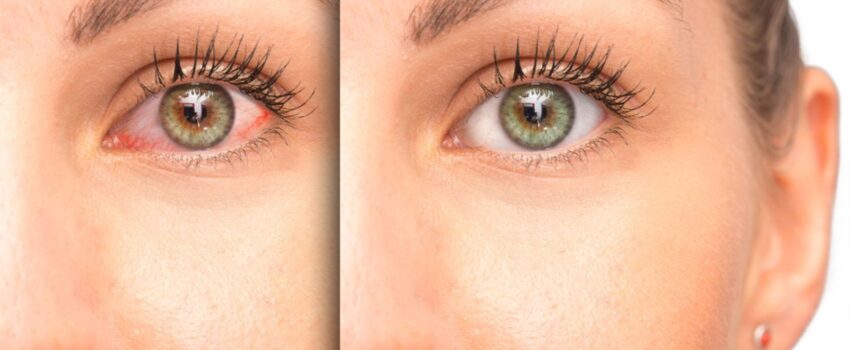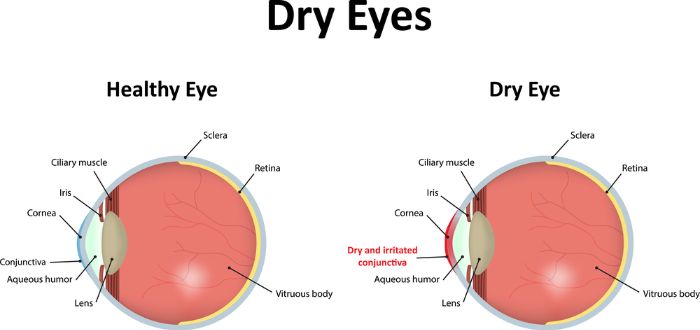Table of Contents
What is Dry Eye?
Dry Eye is a common eye disease that occurs when tears aren’t able to provide adequate lubrication for your eyes or dry eyes may occur if you don’t produce enough tears. It could happen due to many reasons that make tears inadequate and unstable. This irregularity of tears leads to inflammation and damage of the eye’s surface.
Dry eyes make you feel uncomfortable. In such conditions, your eyes may sting or burn. You can feel the Dry Eyes While traveling in an airplane, while riding a bike, in an air-conditioned room or after looking at a computer screen for a few hours.
Dry Eyes Symptoms:
These major Dry Eyes signs and symptoms usually affect both eyes may include:
- Eye redness
- Eye Burning or scratchy sensation
- Sensitivity to light
- Stringy mucus in or around your eyes
- Difficulty wearing contact lenses
- A feeling of having something stuck in your eyes
- Difficulty with nighttime driving
- Blurred vision or eye fatigue
- Watery eyes due to the irritation of dry eyes
Causes of Dry Eyes
The tear film of Eye is made of three layers: fatty oils, aqueous fluid and mucus. This combination of layers keeps the surface of the eyes lubricated, smooth and clear. Any Problems with these layers can cause dry eyes that disrupt the healthy tear film.
Some of the Reasons for Eye tear film dysfunction are –
- Hormone changes.
- Autoimmune disease.
- Inflamed eyelid glands.
- Allergic eye disease.
For In some cases, the cause of dry eyes is decreased tear production or increased tear evaporation.
Decreased tear production
When your eyes are unable to produce enough water (aqueous fluid), Symptoms of Dry eyes can occur. In Medical this condition is known as keratoconjunctivitis sicca.
Common reasons for decreased tear production are:
- Aging
- Corneal nerve insensitivity caused by contact lens use
- Nerve damage or that caused by laser eye surgery, This condition may be temporary.
- Certain medical conditions including Sjogren’s syndrome.
- Allergic eye disease, rheumatoid arthritis, lupus, scleroderma, graft vs. host disease, sarcoidosis, thyroid disorders or vitamin A deficiency
- Certain medications like antihistamines, decongestants
- Hormone replacement therapy or antidepressants.
- Drugs for high blood pressure, acne, birth control and Parkinson’s disease
Increased tear evaporation
Increased tear evaporation occurs when the oil film produced by small glands on the edge of your eyelids (meibomian glands) might block. These Blocked meibomian glands are more common in people with rosacea or other skin disorders. Reasons for increased tear evaporation include:
- Posterior blepharitis (meibomian gland dysfunction
- Vitamin A deficiency
- Blinking less often, due to Parkinson’s disease; or when you’re concentrating during certain activities, such as while reading, driving or working at a computer
- Eye allergies
- Eyelid problems, such as the lids turning outward (ectropion) and the lids turning inward (entropion)
- Wind, smoke or dry air
- Preservatives in topical eyedrops
Risk Factors
Factors that make it more likely that you’ll experience dry eyes include:
- Being older than 50. Tear production tends to diminish as you get older. Dry eyes are more common in people over 50.
- Being a woman. A lack of tears is more common in women, especially if they experience hormonal changes due to pregnancy, using birth control pills or menopause.
- Eating a diet that is low in vitamin A, which is found in liver, carrots and broccoli, or low in omega-3 fatty acids, which are found in fish, walnuts and vegetable oils.
- Wearing contact lenses or having a history of refractive surgery.
Complications of Dry Eyes:
People with dry eyes may experience these complications:
- Eye infections: Our tears protect the eye’s surface from various infections. Due to insufficient tears, the risk of eye infections increased.
- Damage to the eyes’ surface: If treatment of Dry eyes does not start on time, it may lead to eye inflammation, corneal ulcers, abrasion of the corneal surface, and vision loss.
- Decreased quality of life: Dry eyes can make it difficult to perform everyday activities, such as reading.
Prevention
If your eyes developing dry eyes symptoms, do not ignore them. Consultant an Eye Specialist and follows these majors for instance:
- Avoid air blowing near to your eyes: Don’t use hair dryers, car heaters, air conditioners or fans near to your eyes.
- Consider wearing wraparound sunglasses or other protective eyewear.
- Add moisture to the air: You can use a humidifier in winters to add moisture to dry indoor air.
- Take eye breaks during long tasks. Follow the 20-20-20 Rule.
- Position your computer screen below eye level.
- Stop smoking and avoid smoke: Active and Passive smoking both are harmful to the eyes. If you smoke quit it or if not, stay away from people who do. Smoke can worsen dry eyes symptoms.
- Be aware of your environment. The air in desert areas and in airplanes can be extremely dry. Frequently close your eyes in such an environment to develop adequate tears.
- Use artificial tears regularly: In the case of chronic dry eyes, use eye drops to keep them well lubricated.

